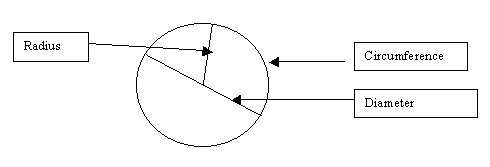
Circles can be great fun and they are so easy to learn about. To understand circles we only need a few basic facts.
These are the ones you need to know.
Key facts
Circumference = the distance around the edge of the circle.
Diameter = a line across the widest part of a circle that passes through the centre.
Radius = 1/2 the diameter.
Maybe a drawing will help you to remember these facts:

You can imagine that measuring the circumference of a circle can be tricky. We could use a piece of string and then put the string against a ruler to measure it.
There is a quicker way, can you remember?
Yes we use the Diameter. We use this because it is easy to measure the diameter of a circle. It's not really tricky.
The diameter is ALWAYS approximately 3 times smaller than the circumference!
Or to put it another way, the circumference is approximately 3 times bigger than the diameter. Look at the table below and see if you can spot the pattern.
|
Diameter |
Circumference |
Approx. |
|
10 cm |
31.4 cm |
10cm X 3 = 30 |
|
2 cm |
6.24 cm |
2cm X 3 = 6 |
|
5 cm |
15.7 cm |
5cm X 3 = 15 cm |
So you can see that multiplying the diameter by 3 gives us a very close answer.
To get the exact answer we have to multiply the diameter by 3.14. This number has got a special symbol and name
The name is PI (pie) and the symbol is π
So we could write the following:
A circumference of any circle is approx. 3 X the diameter.
If we want to be more accurate we could write:
A circumference of a circle is π x the diameter
In the next table try and calculate both the approximate circumference of a circle and the exact circumference.
Use a calculator if you wish.
The first one has been done for you
|
Diameter |
Circumference(approx) |
Circumference |
|
4 cm |
12 cm |
12.56cm |
|
8 cm |
|
|
|
20 cm |
|
|
|
40 cm |
|
|
|
3m |
|
|
|
5 cm |
|
|
Diameter |
Circumference(approx) |
Circumference |
|
4 cm |
12 cm |
12.56cm |
|
8 cm |
24 cm |
25.12cm |
|
20 cm |
60 cm |
62.8cm |
|
40 cm |
120 cm |
125.6cm |
|
3m |
9m |
9.42m |
|
5 cm |
15.7 cm |
15.7cm |
How did you do?
We have not yet talked about the radius. The radius is often more useful than the diameter and we will discuss that another day.
At the moment you only need to know that the radius is half the diameter. To put it another way the diamter is twice the radius.
Look at the pattern
|
Radius |
Diameter |
Circumference |
|
1cm |
2 cm |
6.24cm |
|
10cm |
20cm |
62.4cm |
|
20cm |
40cm |
124.8cm |
You see the radius is 1/2 the diameter and 1/6 the size of circumference.
Review
To find the circumference of a circle X the diameter by 3 to find the approx. size and 3.14 to find an accurate measure.
To find the radius of a circle divide the diameter by 2.
We will cover circle properties again later.
Good luck!